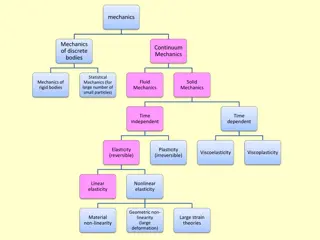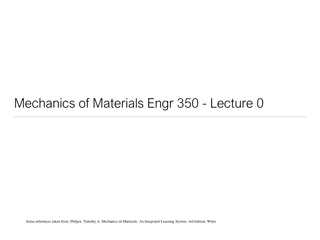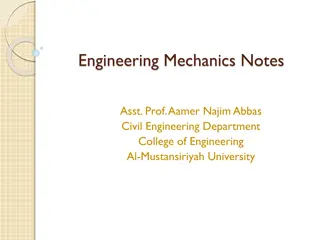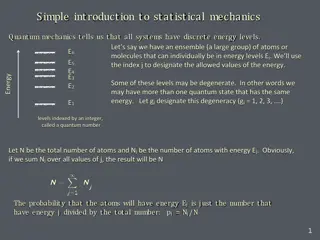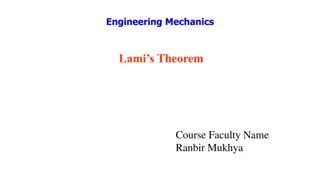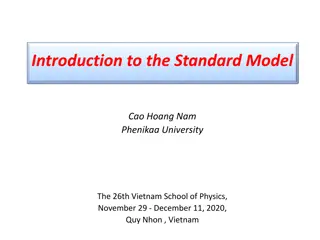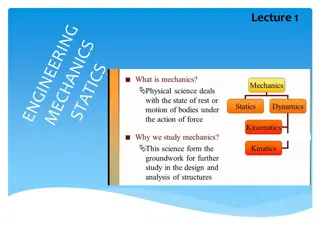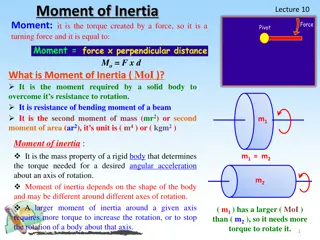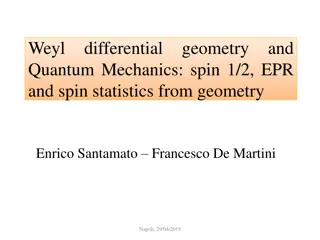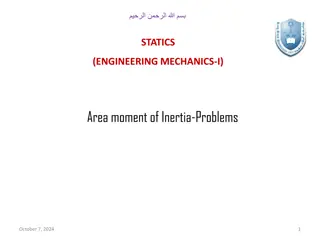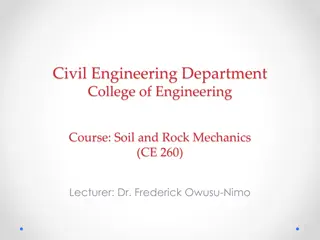Course Overview: Engineering Mechanics-I - Dr. Fahed Alrshoudi
Dive into the fundamentals of statics with Dr. Fahed Alrshoudi's Engineering Mechanics-I course. Covering topics such as force systems, equilibrium, analysis of structures, centroids, moments of inertia, and more, this course aims to equip students with the skills to analyze and solve real-life engineering problems. With a focus on practical applications and in-depth learning outcomes, students will develop a strong foundation in statics principles through lectures, textbook readings, assessments, and hands-on demonstrations.
Download Presentation

Please find below an Image/Link to download the presentation.
The content on the website is provided AS IS for your information and personal use only. It may not be sold, licensed, or shared on other websites without obtaining consent from the author. Download presentation by click this link. If you encounter any issues during the download, it is possible that the publisher has removed the file from their server.
E N D
Presentation Transcript
STATICS (ENGINEERING MECHANICS-I) Lecture #1 Course Description and Introduction By October 7, 2024 GE 201: Dr. Fahed Alrshoudi 2
About the Instructor Name: Dr. Fahed Alrshoudi Designation: Assistant Professor Department: Civil Engineering Office: 2A69 Email: falrshoudi@ksu.edu.sa Website: http://fac.ksu.edu.sa/falrshoudi Office Hours: Displayed on the office wall. October 7, 2024 GE 201: Dr. Fahed Alrshoudi 3
Contents Course Description Course Learning Objectives Objective of the present lecture (#1) Mechanics A Real life application Newton s laws Units October 7, 2024 GE 201: Dr. Fahed Alrshoudi 4
Course Description Force systems; vector analysis, moments and couples in 2D and 3D Equilibrium of force systems Analysis of structures; plane trusses and frames. Distributed force system Centroid of simple and composite bodies Area moments of inertia Analysis of beams Friction October 7, 2024 GE 201: Dr. Fahed Alrshoudi 5
Course Learning Outcomes Students completing this course will be able to Analyze 2D and 3D force system and calculate moment in a 2D and 3D structures Analyze beam, and frame structures using equilibrium equations Analyze truss structures using various methods Locate centroid of regular and composite cross sections Evaluate area moment of inertia of engineering cross sections about different axes. Analyze and solve friction related equilibrium problems October 7, 2024 GE 201: Dr. Fahed Alrshoudi 6
Text Book STATICS Authors: JL Meriam & LG Kraige Publisher: John Wiley & Sons. Edition: Seventh (in SI Units) October 7, 2024 GE 201: Dr. Fahed Alrshoudi 7
Outcome Assessment Two Midterm Exams 5% 10% 40% 45% Model Demonstration and Report Writing Tutorial and Homework Final Exam October 7, 2024 GE 201: Dr. Fahed Alrshoudi 8
Midterm Exams First Midterm Date: 21 Jumada I 1437(1 March 2016 ) Day: Tuesday Time: 5:00pm 6:30 pm Second Midterm Date: 5 Rajab 1437H(12 April 2016) Day: Tuesday Time: 5:00pm 6:30 pm October 7, 2024 GE 201: Dr. Fahed Alrshoudi 9
Objectives of the Present lecture To explain what the Statics is. To provide an overview of the course contents To explain the learning outcomes of the present course October 7, 2024 GE 201: Dr. Fahed Alrshoudi 10
Engineering Mechanics A branch of science concerned with the action of forces on material bodies in rest or in motion Categories of Mechanics: -Rigid bodies -Statics (deals with equilibrium of bodies at rest) -Dynamics (deals with the accelerated motion of bodies) -Deformable bodies -Fluids October 7, 2024 GE 201: Dr. Fahed Alrshoudi 11
A Real Life Application Engineering Design of a building is an application of Statics knowledge. Design of its various components are primarily based on the Principles of Static equilibrium and Strain compatibility. October 7, 2024 GE 201: Dr. Fahed Alrshoudi 12
Newtons Laws Law I: If the resultant force on a particle is zero, the particle will remain at rest (if originally at rest) or will move with constant speed in a straight line (if originally in motion). Law II: The acceleration of a particle is proportional to the resultant force acting on it in the direction of this force. If above Law (II law) is applied to a particle of mass m, it may be stated as force; resultant where = = F a F m resulting = a accelerati on. Law III: The forces of action and reaction between interacting bodies are equal in magnitude, opposite in direction, and collinear. October 7, 2024 GE 201: Dr. Fahed Alrshoudi 13
Weight of the body The gravitational attraction of the earth on a body is known as the weight of the body. This force exists whether the body is at rest or in motion. mg W = Since this attraction is a force, the weight of a body should be expressed in Newtons (N) in SI units and in pounds (lb) in U.S. customary units. Note: Unfortunately in common practice the mass unit kilogram (kg) has been frequently used as a measure of weight. This usage should disappear in time because in SI units the kilogram is used exclusively for mass and the Newton is used for force, including weight. October 7, 2024 GE 201: Dr. Fahed Alrshoudi 14
Law of sines and cosines Law of sines Law of cosines B B c a c a C D A C D A b b a b c = + 2 2 2 2 cos c a b ab 2 C = = sin sin sin A B C = + + 2 2 2 cos c a b ab D October 7, 2024 GE 201: Dr. Fahed Alrshoudi 15
ENGINEERING MECHANICS : STATICS Systems of Units International System of Units (SI) or Metric System : The basic units of length, time, and mass which are defined as meter (m), second (s), and kilogram (kg). The unit of Force is derived as below, = F ma m ( ) = 1 N 1 kg 1 2 s October 7, 2024 GE 201: Dr. Fahed Alrshoudi 16
U. S. Customary UNITS U.S. Customary units (or foot-pound-second (FPS) units): Mass : slugs ( No symbol) Length: foot (symbol ft) Time: second (symbol sec) Force: pound ( symbol lb) Note: In U.S. units the pound is also used on occasion as a unit of mass. When distinction between the two units is necessary, the force unit is frequently written as lbf and the mass unit as lbm. Other units of force in the U.S. system which are in frequent use, are the kilopound (= 1000 lb), and the ton (= 2000 lb) October 7, 2024 GE 201: Dr. Fahed Alrshoudi 17
Thank You For Your Attention Questions October 7, 2024 GE 201: Dr. Fahed Alrshoudi 18




